最好懂的英语时态讲解
高中英语时态全版.ppt

Tom is seeing his friend off at the airport.
.精品课件.
16
过去进行时 表示过去某一时刻或某一段时间内正在进行 的动作。这一特定的过时间可用时间状语表 示
He was watching TV when I came in.
---What were you doing this time yesterday? ---I was writing a letter.
I will study hard to keep up with my classmates.
He won’t do it.
You shall have the book.
.精品课件.
8
2.be going to + 动词原形:含有打算、计划、 准备将做某事的意思,或表示很有可能要发 生的事。
3.若表示已安排或计划好的将来动作或存 在状态,可用一般现在时代替一般将来 时,其谓语动词常为be, come, go, arrive, leave, start等
Where shall we meet tomorrow?
.精品课件.
7
注:shall和will除了上述表示单纯的将来外, 还有其他用法。在第一人称后,will常表示 “决心”、“意愿”或“打算”,在否定
句中用于所有人称,有“不愿”的意思。 shall用于第二人称时,可表示说明者的将 来意愿或允诺。
the window.)
.精品课件.
4
7. 由here, there开头的句子,动词 用一般现在时表示正在发生的动 作。如:
There goes the bell.
Here comes the teacher.
一张图搞懂英语的16个时态

一张图搞懂英语的16个时态| 宝藏秘籍英语时态全解析一说到时态,可能很多高中生就忍不住吐槽:简直就是个磨人的小妖精!面对do,doing,did,done,had done·····一大堆长得差不多的字符,真想一把火把书烧掉!可时态作为英语的基础项,又不能丢在一遍不管不顾。
在语法体系里,时态看起来变来变去很容易混淆,其实只是因为学生的脑子里对时态还没有清晰的理解和差异化分类,在对应的语境里也就不知道该用什么时态。
理清这张图,时态其实也就那么一回事。
1一般现在时(do/does; is/am/are)①表示现在的情况、状态或特征。
例:He is a student.他是一个学生。
②表示经常性、习惯性动作。
例:He always helps others.他总是帮助别人。
③客观事实和普遍真理。
例:The earth moves the sun.地球绕着太阳转。
④表示一个按规定、计划或安排要发生的动作。
仅限于某些表示“来、去、动、停、开始、结束、继续”等的动词,可以与表示未来时间的状语搭配使用。
常见的用法是:飞机、火车、轮船、汽车等定期定点运行的交通方式。
例:The next train leaves at 3 o'clock this afternoon.下一趟火车今天下午3点开车。
⑤在时间、条件和让步状语从句中经常用一般现在(有时也用现在完成时)表示将的来事情。
(即:主将从现原则)例:I will call you as soon as I arrive at the airport.我一到机场就会给你打电话2现在进行时(am/is/are doing)① 表示此时此刻正在发生的事情。
例:He is listning to the music now.他现在正在听音乐。
② 表示目前一段时间内一直在做的事情,但不一定此时此刻正在做。
例:I am studying computer this term.这个学期我一直在学习计算机。
英语十六种时态ppt课件

6
2.一般过去时的肯定、疑问、否定三种形式
肯定式
疑问式
否定式
I worked.
Did I work?
I did not work.
He (She, It)worked. Did he (she, it) work? He (She, It) did not work.
13
范围扩展
1. 用过去进行时表示现在主要是为了使语气委婉、客气。 I was wondering if you can give me a lift. 我不知你能否让我搭一下车。 (一般过去时也有类似用法,但比较而言,用过去进
行时显得更客气,更加不肯定。)
2.动词be的过去进行时也可表示过去一时的表现或暂时的 状态。
现在进行时表示说话时正在进行的动作或表示目前一段时 间内正在进行的活动,与现在进行时连用的时间状语有now, these days等。
—What is your mother doing now? 你的妈妈正在干什么? —She is cooking for us. 她正在为我们做饭。 2.现在进行时的具体用法
10
用法
例句
(1) 说话瞬间正在发生的动作,常见的时间 They are watching TV now.
状语有now,at the moment等。如果句首有 他们现在正在看电视。
警示性动词look,listen等,主句的动词也 Listen! The bird is singing in the tree.
(2) be (am, is, are) going to + 动词原形 2.一般将来时的用法
英语八种时态讲解及练习

现在进行时
作谓语的动词用来表示动作(情况) 发生时间的各种形式称为时态。
1.概念:表示现阶段或说话时正在 进行的动作及行为。 2.时间状语:Now, at this time, days, look. listen等时间状语做标志。 3.基本结构:主语+be +doing +其 他 4.否定形式:主语+be +not +doing+ 其他 5.一般疑问句:把be动词放于句首。
现在分词的变法有
1)、一般在动词词尾加上-ing ,E.g. jump 2)、以不发音字母e结尾的动词,先 去e,再加-ing. E.g have write 3)、.以重读闭音节末尾只有一个辅 音字母结尾的词,它前面是单个元 音字母时要先将词尾的辅音字母双 写,再加上-ing. E.g. sit put 其句式 变换都在be上做文章。
10. I will go there when I _____(have, will have, has) time tomorrow. 11. He won’t come to the party unless he _____(be, will be, am, is, are) invited. 12. I’ll wait here until my mother ____(come, comes, will come) back. 13. Please return the book to the library as soon as you ______(finish, finishes, will finish) reading it. 14. Once you _____(see, sees, will see) him, you will never forget him.
英语16种时态讲解
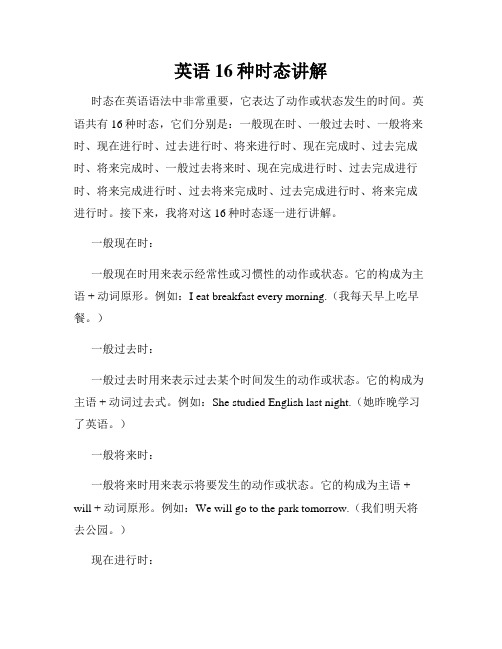
英语16种时态讲解时态在英语语法中非常重要,它表达了动作或状态发生的时间。
英语共有16种时态,它们分别是:一般现在时、一般过去时、一般将来时、现在进行时、过去进行时、将来进行时、现在完成时、过去完成时、将来完成时、一般过去将来时、现在完成进行时、过去完成进行时、将来完成进行时、过去将来完成时、过去完成进行时、将来完成进行时。
接下来,我将对这16种时态逐一进行讲解。
一般现在时:一般现在时用来表示经常性或习惯性的动作或状态。
它的构成为主语 + 动词原形。
例如:I eat breakfast every morning.(我每天早上吃早餐。
)一般过去时:一般过去时用来表示过去某个时间发生的动作或状态。
它的构成为主语 + 动词过去式。
例如:She studied English last night.(她昨晚学习了英语。
)一般将来时:一般将来时用来表示将要发生的动作或状态。
它的构成为主语 + will + 动词原形。
例如:We will go to the park tomorrow.(我们明天将去公园。
)现在进行时:现在进行时用来表示现在正在进行的动作。
它的构成为主语 +am/is/are + 动词-ing形式。
例如:He is watching TV now.(他正在看电视。
)过去进行时:过去进行时用来表示过去某个时间正在进行的动作。
它的构成为主语 + was/were + 动词-ing形式。
例如:They were playing soccer yesterday.(他们昨天正在踢足球。
)将来进行时:将来进行时用来表示将来某个时间正在进行的动作。
它的构成为主语 + will be + 动词-ing形式。
例如:I will be studying in the library tomorrow.(明天我将在图书馆学习。
)现在完成时:现在完成时用来表示过去发生但与现在有关的动作或状态。
它的构成为主语 + have/has + 动词过去分词。
高考英语时态讲解

高考英语时态讲解在英语中,时态是一种表达动词时间属性的语法形式。
在高考英语中,掌握时态的正确使用是非常重要的。
本文将详细讲解英语中的常见时态,帮助考生在高考英语考试中正确使用时态。
一、一般现在时一般现在时是英语中最基本的时态之一,它表示经常发生的动作或存在的状态。
一般现在时的基本形式是动词原形,如:I go to school every day。
在大多数情况下,动词第三人称单数和复数形式以及名词的复数形式也要加上-s或-es。
二、现在进行时现在进行时表示正在进行的动作或存在的状态。
它的基本形式是动词的现在分词形式,如:I am studying。
现在进行时通常与now,right now等时间状语连用。
三、现在完成时现在完成时表示过去发生的动作对现在造成的影响或结果。
它的基本形式是have/has +过去分词,如:I have finished my homework。
现在完成时通常与already,yet等副词连用。
四、一般过去时一般过去时表示过去发生的动作或存在的状态。
它的基本形式是动词的过去式,如:I went to the park yesterday。
在大多数情况下,动词第三人称单数和复数形式以及名词的复数形式也要加上-ed或-d。
五、过去进行时过去进行时表示过去正在进行的动作或存在的状态。
它的基本形式是was/were +现在分词,如:I was studying at this time yesterday。
过去进行时通常与at this time yesterday等时间状语连用。
六、过去完成时过去完成时表示过去的过去发生的动作对过去造成的影响或结果。
它的基本形式是had +过去分词,如:I had finished my homework before dinner。
过去完成时通常与already,yet等副词连用。
七、一般将来时一般将来时表示将来要发生的动作或存在的状态。
它的基本形式是will +动词原形,如:I will go to school tomorrow。
高中英语16种时态用法讲解(附例句)

高中英语16种时态用法讲解(附例句)1. 一般现在时 simple present tense用法:A) 表示现在发生的动作、情况、状态和特征【例】My father is not home yet. 我父亲还没回家.She is a student. 她是一个学生。
B) 经常性、习惯性动作,常与表示频度的副词连用,如always,often,seldom等【例】He always eats an apple in the morning. 他常常在早上吃一个苹果。
C) 表示客观事实和普遍真理The earth moves around the sun. 地球绕太阳转动。
D) 表示按计划安排好的,或将要发生的动作,可用一般现在表将来,但仅限于start, leave, go, arrive, begin等单词【例】The train leaves at 3:00 p.m.. 火车三点发车。
The show begins in half an hour. 半小时后演出开始。
E) 在时间和条件状语从句中,主句是将来时,从句通常用一般现在(有时也用现在完成时)表示将来事情【例】I will go to bed when he comes back. 等他回来了我就去睡觉。
If you don't stop the yelling, I will leave right now. 如果你还继续大吼大叫的话,我现在就走。
2. 现在进行时 present progressive tense用法:A) 表示说话时正在进行的动作【例】They are having lunch. 他们在吃饭。
B) 表示现阶段正在进行的动作【例】We are looking for a new house. 我们现在在找新房子。
3. 现在完成时 present perfect tense用法:A) 表示动作到现在为止已经完成或刚刚完成【例】I have just finished my homework. 我刚刚才写完作业。
初中英语八大时态讲解
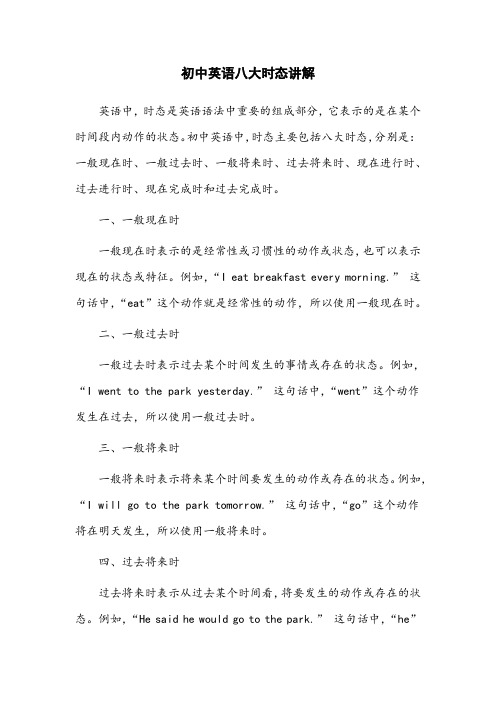
初中英语八大时态讲解英语中,时态是英语语法中重要的组成部分,它表示的是在某个时间段内动作的状态。
初中英语中,时态主要包括八大时态,分别是:一般现在时、一般过去时、一般将来时、过去将来时、现在进行时、过去进行时、现在完成时和过去完成时。
一、一般现在时一般现在时表示的是经常性或习惯性的动作或状态,也可以表示现在的状态或特征。
例如,“I eat breakfast every morning.”这句话中,“eat”这个动作就是经常性的动作,所以使用一般现在时。
二、一般过去时一般过去时表示过去某个时间发生的事情或存在的状态。
例如,“I went to the park yesterday.”这句话中,“went”这个动作发生在过去,所以使用一般过去时。
三、一般将来时一般将来时表示将来某个时间要发生的动作或存在的状态。
例如,“I will go to the park tomorrow.”这句话中,“go”这个动作将在明天发生,所以使用一般将来时。
四、过去将来时过去将来时表示从过去某个时间看,将要发生的动作或存在的状态。
例如,“He said he would go to the park.”这句话中,“he”认为“he would go to the park”是未来要发生的事情,所以使用过去将来时。
五、现在进行时现在进行时表示正在进行的动作或存在的状态。
例如,“I am eating an apple.”这句话中,“eating”这个动作正在进行,所以使用现在进行时。
六、过去进行时过去进行时表示过去某个时间正在进行的动作或存在的状态。
例如,“She said she was watching TV at 8 o’clock last night.”这句话中,“watching TV”这个动作在昨晚8点正在进行,所以使用过去进行时。
七、现在完成时现在完成时表示过去发生的动作对现在造成的影响或结果,也可以表示持续到现在的动作或状态。
英语八大时态讲解

英语八大时态讲解
英语的八大时态包括:一般现在时,一般过去时,现在进行时,过去进行时,一般将来时,过去将来时,现在完成时,过去完成时。
以下是每个时态的详细讲解:
一般现在时:表示经常性或习惯性动作,常与表频度的时间状语连用,如She often speaks English。
也可以表示现在的状态、特征、职业、能力、感觉等,如He seems to feel a bit down today。
此外,它还可以表示真理、客观存在、科学事实或用于格言警句中,如Shanghai lies in the east of China。
一般过去时:表示发生在过去的动作或存在的状态,通常与表示过去的时间状语yesterday,last night,some years ago,in 1990等连用。
现在进行时:表示正在进行的动作或存在的状态,如I am studying now。
过去进行时:表示在过去某个时间点正在进行的动作或存在的状态,如She was studying at 8 o’clock yesterday。
一般将来时:表示将来要发生的动作或存在的状态,如I will go to school tomorrow。
过去将来时:表示在过去某个时间点看来将要发生的动作或存在的状态,如She said she would come to see me the next day。
现在完成时:表示过去发生的动作持续到现在,并可能继续下去,如I have studied English for 5 years。
过去完成时:表示在过去某个时间点之前已经完成的动作或存在的状态,如He said he had finished his homework。
英语的六大时态用法及结构

英语的六大时态用法及结构
英语语言中有六种主要的时态,它们分别是,简单现在时(Simple Present)、简单过去时(Simple Past)、简单将来时(Simple Future)、现在进行时(Present Continuous)、过去进
行时(Past Continuous)和过去完成时(Past Perfect)。
下面我
将逐一介绍这些时态的用法和结构。
1. 简单现在时(Simple Present),表示经常性的动作、习惯、客观真理或现在的状态。
其结构为主语 + 动词原形(第三人称单数时,动词要加-s或-es)。
2. 简单过去时(Simple Past),表示过去某个时间发生的动
作或状态。
其结构为主语 + 动词过去式。
3. 简单将来时(Simple Future),表示将来某个时间会发生
的动作或状态。
其结构为主语 + will + 动词原形。
4. 现在进行时(Present Continuous),表示现在正在进行的
动作。
其结构为主语 + am/is/are + 动词-ing 形式。
5. 过去进行时(Past Continuous),表示过去某个时间正在进行的动作。
其结构为主语 + was/were + 动词-ing 形式。
6. 过去完成时(Past Perfect),表示过去某个时间之前已经发生的动作。
其结构为主语 + had + 过去分词。
以上就是英语的六大时态的用法和结构的简要介绍。
当然,每种时态还有一些特殊的用法和注意事项,希望这些信息对你有所帮助。
16种英语时态讲解PPT课件
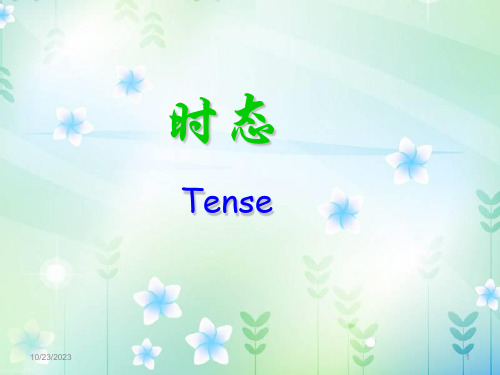
10/23/2023
8
五、现在进行时态
现在进行时的基本用法
形式: am/is/are + doing
用法1: 表示说话此刻动作正在进行.
• He is not available now. he is talking on the phone.
• Please don’t make so much noise. I am studying.
时态
Tense
10/23/2023
1
一、时态概述
16种时态 一般动作
现在 一般现在
过去 一般过去
进行动作 现在进行 过去进行
完成动作 现在完成 过去完成
完成进行动 现在完成
作
进行
过去完成 进行
将来 一般将来 将来进行 将来完成 将来完成
进行
过去将来 一般过去将来 过去将来进行 过去将来完成 过去将来完成
此用法常与一些表示动作频率的时间副词连用(副词放在be动词之 后, 实义动词之前).
1) 表示肯定的频率副词: always, frequently, usually, sometimes, often, occasionally, generally 等.
2) 表示否定的频率副词: never, seldom, rarely 等.
10/23/2023
6
四、一般将来时态
一般将来时的基本用法
形式:
will do 或be going to do
用法1: 表示预测将要发生某事,用will或be going to do.
1) be going to 特别意指根据目前的明显迹象来推断某件事 要发生; will 则只是表名说话人认为或相信某件事要发生
16张图看懂英语16大时态
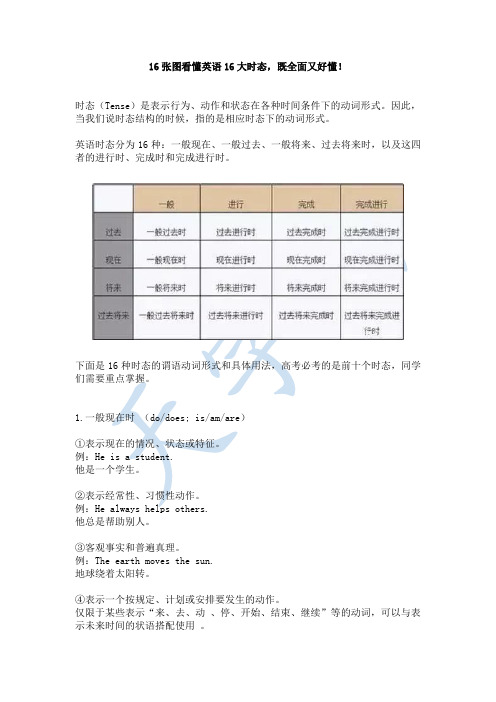
16张图看懂英语16大时态,既全面又好懂!时态(Tense)是表示行为、动作和状态在各种时间条件下的动词形式。
因此,当我们说时态结构的时候,指的是相应时态下的动词形式。
英语时态分为16种:一般现在、一般过去、一般将来、过去将来时,以及这四者的进行时、完成时和完成进行时。
下面是16种时态的谓语动词形式和具体用法,高考必考的是前十个时态,同学们需要重点掌握。
1.一般现在时(do/does; is/am/are)①表示现在的情况、状态或特征。
例:He is a student.他是一个学生。
②表示经常性、习惯性动作。
例:He always helps others.他总是帮助别人。
③客观事实和普遍真理。
例:The earth moves the sun.地球绕着太阳转。
④表示一个按规定、计划或安排要发生的动作。
仅限于某些表示“来、去、动、停、开始、结束、继续”等的动词,可以与表示未来时间的状语搭配使用。
常见的用法是:飞机、火车、轮船、汽车等定期定点运行的交通方式。
例:The next train leaves at 3 o'clock this afternoon.下一趟火车今天下午3点开车。
⑤在时间、条件和让步状语从句中经常用一般现在(有时也用现在完成时)表示将的来事情。
(即:主将从现原则)例:I will call you as soon as I arrive at the airport.我一到机场就会给你打电话。
When you have finished the report, I will have waited for about 3 hours. 等你完成这份报告的时候,我就已经等了将近3个小时了。
2. 现在进行时(am/is/are doing)①表示此时此刻正在发生的事情。
例:He is listening to the music now.他现在正在听音乐。
②表示目前一段时间内一直在做的事情,但不一定此时此刻正在做。
初中英语八大时态讲解_图文

2 have been to+地点,表示“去过某地”
。(人已回) I have been to Europe. (I am not in Europe now.)
3 have been in+地点+时间段,表示“在/ 来某地多久”。
I have been in Europe for three weeks. (I am now still in Europe .)
go there get home open close get to know borrow buy
be there be home be open be closed know keep have
1.The film began 5 The film_h_a_s b_e_en_o_n__ for 5
• 9.They got to know 10 They_h_av_e_k_n_o_w_n__since 10
years ago.
years ago.
• 10.I borrowed the book a I_h_a_v_e _k_e_p_t _the book for a
week ago.
week.
二、一般过去时
1.用法:过去的动作或状态。
2.标志词:
yesterday, the day before yesterday,
three days ago, last night/week/month…,in the past;just
now=a moment ago
例题
Li Ming didn’t understand what American people
4.He joined the club 3 He__h_as_b_e_en_i_n__the club for
初中英语时态讲解(完整版)
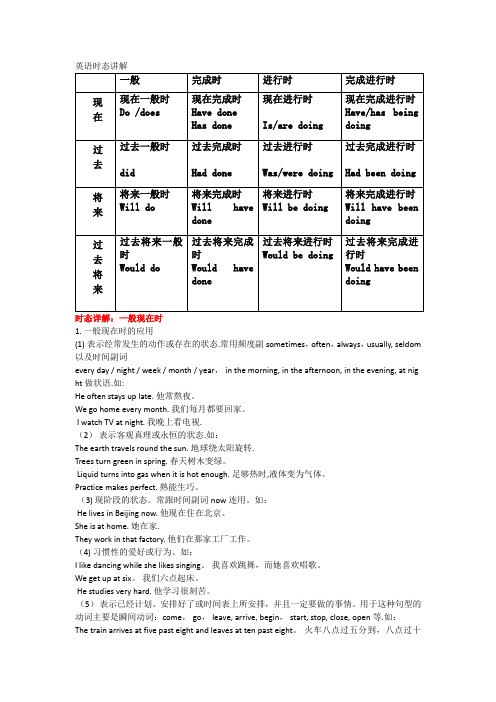
英语时态讲解1.一般现在时的应用(1)表示经常发生的动作或存在的状态.常用频度副sometimes,often,always,usually,seldom 以及时间副词every day/night/week/month/year,in the morning,in the afternoon,in the evening,at nig ht做状语.如:He often stays up late.他常熬夜。
We go home every month.我们每月都要回家。
I watch TV at night.我晚上看电视.(2)表示客观真理或永恒的状态.如:The earth travels round the sun.地球绕太阳旋转.Trees turn green in spring.春天树木变绿。
Liquid turns into gas when it is hot enough.足够热时,液体变为气体。
Practice makes perfect.熟能生巧。
(3)现阶段的状态。
常跟时间副词now连用。
如:He lives in Beijing now.他现在住在北京。
She is at home.她在家.They work in that factory.他们在那家工厂工作。
(4)习惯性的爱好或行为。
如:I like dancing while she likes singing。
我喜欢跳舞,而她喜欢唱歌。
We get up at six。
我们六点起床。
He studies very hard.他学习很刻苦。
(5)表示已经计划、安排好了或时间表上所安排,并且一定要做的事情。
用于这种句型的动词主要是瞬间动词:come,go,leave,arrive,begin,start,stop,close,open等.如:The train arrives at five past eight and leaves at ten past eight。
英语16种时态详解,史上最全

英语16种时态详解,史上最全英语动词时态详解:⼀般现在时■湖南陈根花⼀、⼀般现在时表现在1.表⽰现在经常性或习惯性的动作。
如:My sister wears glasses. 我妹妹戴眼镜。
He often goes to the cinema. 他经常去看电影。
【注】询问某⼈的习惯时,有时还可⽤ever。
如:“Do you ever eat meat?” “No, I never eat meat.”“你吃⾁吗?”“从不吃⾁。
”2.表⽰现在(或经常性)的情况或状态。
如:Mother is ill. 母亲病了。
He is always like that. 他总是那样。
He likes living in the country. 他喜欢住在乡下。
We need a lot of money. 我们需要⼀⼤笔钱。
3.表⽰现在的能⼒、特征、职业等。
如:He sings well. 他唱歌唱得好。
Mr. Smith teaches French. 史密斯先⽣教法语。
4.表⽰客观真理、科学事实、格⾔以及不受时间限制的客观存在。
如:Summer follows spring. 春去夏来。
Knowledge is power. 知识就是⼒量。
The earth turns around the sun. 地球绕着太阳转。
⼆、⼀般现在时表将来1.当主句为将来时态或表⽰将来意义时,时间和条件的状语从句必须⽤⼀般现在时表将来。
如:I?ll write to her when I have time.我有空会给她写信。
Turn off the lights before you leave. ⾛前关灯。
If we hurry, we may catch the bus. 如果赶紧⾛我们可能赶得上公共汽车。
Tell me in case you get into difficulty. 遇到困难请告诉我。
【注】①除表⽰时间和条件的状语从句外,表⽰让步、相似、⽐例的从句也必须⽤⼀般现在时表⽰将来。
- 1、下载文档前请自行甄别文档内容的完整性,平台不提供额外的编辑、内容补充、找答案等附加服务。
- 2、"仅部分预览"的文档,不可在线预览部分如存在完整性等问题,可反馈申请退款(可完整预览的文档不适用该条件!)。
- 3、如文档侵犯您的权益,请联系客服反馈,我们会尽快为您处理(人工客服工作时间:9:00-18:30)。
最好懂的英语时态讲解:一般现在时
(1)
阳春白雪教育2018-01-02 11:10:21
本老师反对用满嘴的专业术语给娃儿们上英语课的。
孩子们缺乏语言基础,本来听课就难,满口专业术语,娃儿们咋会听懂用他这个年龄的心智能接受的语言把英语讲明白,就成。
一般现在时详解↓↓↓
视频加载中...
一般现在时
一.啥是一般现在时
就是平常好做的事儿。
二.用法(3个)
1. 好做的事儿:
I go to school every day.
He go es to the zoo every week.
2. 近段时间的状态:
It is hot these days.
He needs help.
3. 自然现象:
The moon move s around the earth.
三.标志词
1、常用 always, usually, often, sometimes,hardly,never等,表示频繁程度。
频繁程度由高到低排序:always> usually> often> sometimes > seldom> hardly> never
例子:Sue 经常在早上六点起床。
Sue often get s up at six o’clock.
2、in the morning / afternoon / evening, at noon / night, every day, once
a week,on Sundays等。
例子: 他每周去一次动物园。
He go es to the zoo once a week.
四.动词用法
1、用 be 动词表示样子:
I am busy.→ Are you busy
He is old. → Is he old
2、实意动词(就是看到听到这词语,你就能想到一个动作)。
I go to the park every Sunday.
→Do you go to the park every Sunday
→No, I don't go to the park every Sunday.
3. 注意单三(你我之外另一个人):
Our English teacher often comes to school early.
→Does your English always come to school early
→Yes, she does.
4. 动词+s 规则:
直接+s;
以x、s、ch、sh结尾的+es;
辅音+y结尾的,把y变i+es;
特殊变化:have→has.
五.特殊疑问句:
其实就是:疑问词 + 一般疑问句
疑问词:what, where, when, which, why, who, how
例:I want an apple. → What do you want
She wants an apple.→What does she want
I often have lunch at 12 o’clock. → When do you often have lunch She often has lunch at 12 o’clock. → When does she often have lunch
【学生常犯错误】
1、be动词与行为动词同时出现在句子中
如:We are plant(plant) the trees in spring. 多了个单词 are .
解析:are 和 am, is 是一家的,属于be 动词,在英语动词结构中,be 后面再跟动词的话,要么是be + -ing 表示正在干啥,要么是be + 过分表示被动,没有 be后面是动词原形的结构。
2、单三作主语,总是丢 s 。
如:He always go to the cinema on weekends. 句中的go应该是goes。
3、句式变换易出错。
如:Does Jenny has (has) a good friend has 应该是 have.
Brian doesn’t lives (not live) in China. lives应该是live.
解析:助动词是个照妖镜,后面动词现原形
四、对do的理解易出错。
如:We don’t (not do) our homework in the afternoon.句中应该是don’t do.
解析:前面 don't 是 do not 的缩写,这个do是个助动词,只是个帮忙的,帮谁呢帮后面的那个 do ,后面的那个才是实意动词,表示动作---做作业的“做”。
五、对主语误判。
如:Li Ming with me are (be) in Beijing. 应该把are 改成 is
解析: with me 作状语,表示伴随。
换个语序一看便知:Li Ming is in Beijing with me.。
